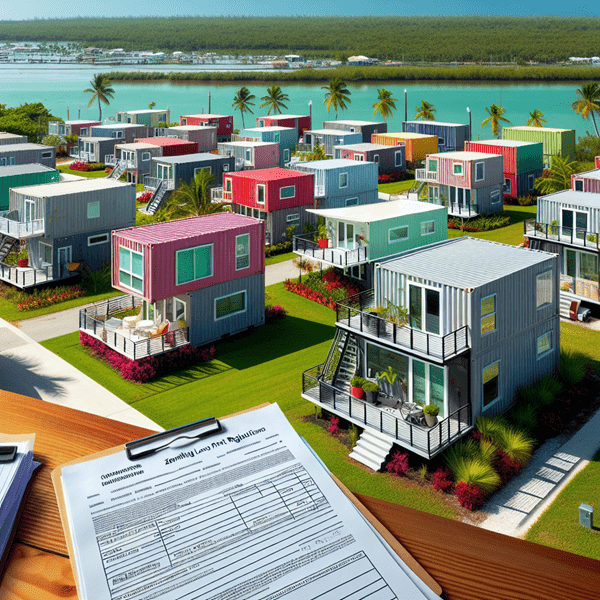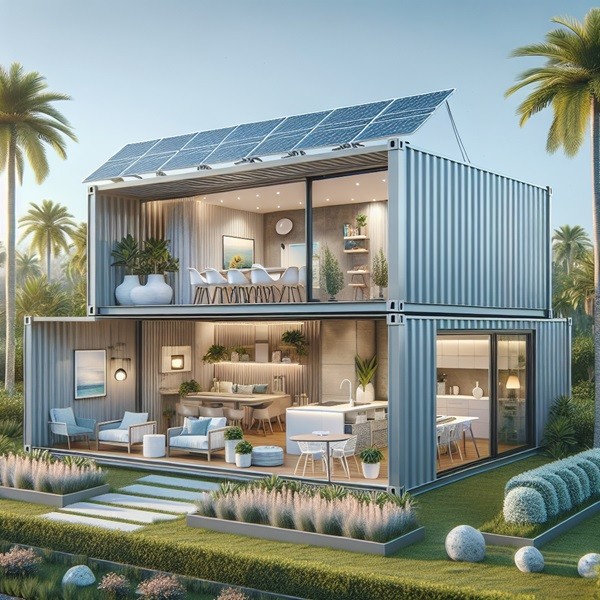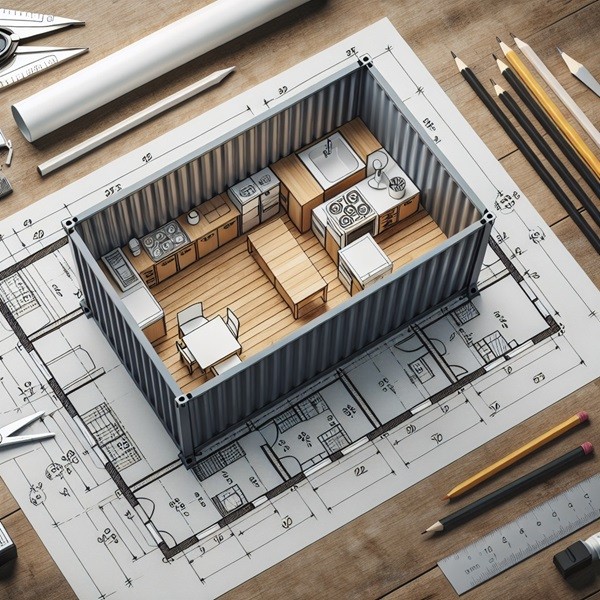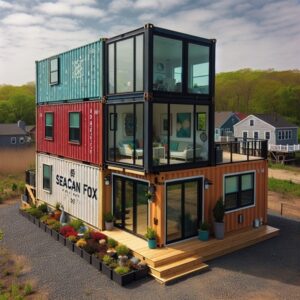
Key Takeaways: Florida’s Regulatory Landscape for Container Homes
- Research local zoning laws to ensure container homes are allowed in your desired area.
- Align your container home design with the specific requirements of your zoning district.
- Obtain all necessary permits before beginning construction to avoid legal issues.
- Design your home to withstand Florida’s climate, including hurricanes and floods.
- Maintain compliance by staying informed about changes in regulations and performing regular home maintenance.
Overview of the Florida Building Landscape
Before you dive into building your own shipping container home in Florida, it’s important to understand the lay of the land—literally. Florida’s landscape is as varied as its population, with coastal areas prone to flooding, urban centers with strict building codes, and rural locales where regulations might be more relaxed.
Here’s a snapshot of what you need to know:
My Favorite Container Homes Resource
I compared the top 3 Container Home Guides
to discover the ultimate resource!
See my top recommendation here
- Coastal Zones: These areas have specific regulations to protect against flooding and hurricane damage.
- Urban Areas: Expect more stringent building codes, including regulations on size, appearance, and placement of container homes.
- Rural Regions: You might find more freedom here, but it’s still crucial to check local ordinances before proceeding.
Understanding this diverse building landscape is the first step to ensuring your container home project is successful and compliant with local regulations.
Navigating Zoning Laws for Shipping Container Homes in Florida
Zoning laws can be the make-or-break factor for your shipping container home. These laws determine where you can build, what you can build, and how you can use your property. It’s not just about following the rules—it’s about making the rules work for you.
Understanding Zoning Districts and Container Homes Compatibility
Florida’s zoning districts are as varied as its ecosystems, and each one has its own set of rules. Residential zones might welcome container homes with open arms, while industrial zones could be more restrictive. The key is to match your vision with the right location.
Here’s what you should do:
- Research your desired area’s zoning classifications.
- Identify if shipping container homes are explicitly mentioned in the zoning ordinances.
- Look for any restrictions on building materials, which could affect your plans.
Getting clear on these details early on can save you a world of hassle down the line.
Devising a Strategy to Align with Local Zoning Requirements
Once you’ve got a handle on the zoning laws, it’s time to strategize. If the local laws are favorable, you’re in the clear to proceed with designing your home. If not, don’t lose hope—there may be ways to appeal or apply for variances that allow for your unique build.
Consider these steps:
- Connect with local officials to discuss your project and get their insights.
- Prepare a compelling case for your container home, highlighting its benefits and how it aligns with the community’s values.
- Be willing to adapt your design to meet certain requirements if necessary.
Remember, patience and persistence are your best allies when navigating zoning laws.
Unlock the Door to Your Dream Home with the Right Permits
Permits are the golden tickets to building your shipping container home. They’re proof that your project meets local standards and is officially sanctioned to proceed. Skipping this step isn’t just risky—it’s a surefire way to get your project shut down.
So, how do you get these all-important permits? It starts with understanding what’s required in your area. You’ll likely need a combination of building, electrical, plumbing, and possibly other specialized permits. The process can seem daunting, but with careful planning and a little know-how, you can navigate it like a pro.
Here’s what you need to focus on:
- Gather all necessary documentation, including your building plans and property surveys.
- Visit your local building department to submit your application and learn about the review process.
- Be prepared for inspections at various stages of construction to ensure everything is up to code.
Securing the right permits is a critical step in bringing your shipping container home from concept to reality. With them in hand, you’re ready to build a home that’s as unique as you are, right here in Florida.
A List of Must-Have Permits for Container Home Building
Before you start cutting windows into that corrugated steel, let’s talk permits. These are the non-negotiables, the must-haves before you can legally call your shipping container a home:
- Building Permit: This is the big one, giving you the green light to construct your home.
- Zoning Permit: This ensures your home fits within the local zoning laws.
- Electrical Permit: For all your wiring needs, because no one likes to be left in the dark.
- Plumbing Permit: Water is life, and this permit ensures it flows correctly in your home.
- Mechanical Permit: If you’re installing heating and cooling systems, this is a must.
- Septic Permit: For homes not connected to municipal sewer systems, this is crucial.
Each permit serves as a checkpoint, ensuring that every aspect of your home is safe, sound, and in line with the law.
How to Smoothly Navigate the Permitting Process
The permitting process can seem like a maze, but with the right approach, you can navigate it with ease. Here’s how to keep things moving smoothly:
- Start early and give yourself plenty of time to gather information and submit applications.
- Make friends with the folks at your local building department—they’re a wealth of knowledge and can guide you through the process.
- Be organized. Keep copies of all your documents, applications, and correspondence. You’ll thank yourself later.
- Expect to make revisions. Rarely does a plan pass without a few tweaks, so stay flexible and cooperative.
- Follow up regularly. A polite phone call can keep your project fresh in the minds of the reviewers.
By taking these steps, you’ll find that the path to permit approval is smoother than you might have anticipated.

Aligning Your Container Home With Florida’s Building Codes
Building codes are the rulebook for safe construction practices, and in Florida, they’re especially important. They ensure that your home is not only structurally sound but also able to stand up to the state’s unique environmental challenges.
Essential Code Considerations for Container Home Foundations
The foundation of your home is exactly that—the foundation. It needs to be strong, stable, and up to code. Here’s what to keep in mind:
- Your foundation must be designed to support the weight of your container home, including any modifications and contents.
- It should be elevated appropriately, especially in flood-prone areas, to prevent water damage.
- Consider the soil type and terrain of your property; this can affect the
you’ll need.
Getting your foundation right is critical, so don’t hesitate to consult with a structural engineer to ensure your home has a solid base to stand on.
Designing to Withstand Florida’s Unique Climate Challenges
Florida’s weather can be as unpredictable as a game of cards. Your container home needs to be ready for anything—from scorching heat to hurricane-force winds.
- Insulation: Proper insulation will keep your home cool during those hot Florida summers and warm during the occasional chilly winter night.
- Ventilation: Good airflow is essential to prevent mold and maintain indoor air quality.
- Wind resistance: Your home should be able to withstand high winds, so consider reinforcements and anchoring techniques.
Designing with the climate in mind will not only keep you comfortable but also reduce your energy bills and maintenance costs in the long run.
Building Container Homes in Florida’s Coastal Areas
Coastal living is a dream for many, but it comes with its own set of challenges. If you’re setting your sights on a shipping container home near Florida’s beautiful beaches, here’s what you need to know:
Constructing Homes to Endure the High Seas: Flood Zone Considerations
Flood zones are a reality in coastal Florida, and they can’t be ignored. Building in these areas means extra precautions:
- Elevate your home. FEMA’s guidelines can help determine the right height to keep your home above potential floodwaters.
- Choose materials that can withstand moisture and saltwater exposure.
- Consider breakaway walls that can minimize damage during a flood.
With careful planning and the right design choices, your container home can be a safe haven, even in the face of rising tides.
Weathering the Storm: Hurricane-Proofing Your Container Home
Florida’s hurricane season is no joke, and your container home needs to be prepped and ready to face the fury of Mother Nature. Reinforced walls, impact-resistant windows, and secure doors are just the start. Here’s how to ensure your container home stands strong:
- Anchor it down. Use heavy-duty anchors and fasteners to keep your home grounded against high winds.
- Choose the right windows. Impact-resistant glass can be a lifesaver when debris is flying.
- Don’t skimp on the roof. A sturdy, well-secured roof is essential to prevent uplift and water damage.
- Inspect seals and joints regularly. Even the smallest gap can lead to big problems in a storm.
By taking these steps, you’re not just building a home; you’re building a fortress that can stand up to the toughest storms.

Maximizing the Benefits of Container Homes While Complying with Regulations
Container homes are more than just a place to live; they’re a way to embrace a lifestyle that’s both innovative and responsible. But to truly reap the benefits, you need to play by the rules. Compliance with regulations ensures your home is safe, sustainable, and set for the long haul.
Eco-Friendly and Sustainable Living in a Shipping Container Home
Living in a shipping container home isn’t just about being trendy; it’s about making a positive impact on the environment. These homes reduce the need for new construction materials and can be outfitted with green technologies like solar panels and rainwater collection systems. Here’s how to make your container home a beacon of sustainability:
- Insulate wisely. Eco-friendly insulation options can keep your energy consumption low.
- Go solar. Florida’s sunny days are perfect for solar power, reducing your reliance on the grid.
- Collect rainwater. A rainwater harvesting system can supply you with water for non-potable uses.
- Plant a green roof or garden. It’s not just aesthetically pleasing; it also helps with insulation and biodiversity.
Every eco-friendly choice you make is a step towards a cleaner, greener future for all.
Tips for Ensuring Long-Term Compliance and Home Maintenance
Maintaining compliance with regulations isn’t a one-time deal; it’s an ongoing commitment. Regular maintenance ensures your container home stays up to code and in top condition. Keep these tips in mind:
- Stay informed. Regulations can change, so keep up-to-date with local building codes and zoning laws.
- Schedule regular inspections. Regular check-ups can catch issues before they become major problems.
- Keep records. Document any upgrades or repairs in case you need to prove compliance down the line.
- Invest in quality. Choosing high-quality materials and finishes can reduce the need for frequent repairs.
Think of compliance as the guardian of your investment, ensuring your home remains a safe and valuable asset.
Setting the Blueprint for a Successful Shipping Container Home Project
Every great container home starts with a solid plan. From the initial concept to the final touches, careful planning and research set the stage for a smooth build. It’s about more than just the aesthetics; it’s about creating a home that’s both functional and compliant with Florida’s unique building requirements.
The Importance of Planning and Research Before Construction
Before you break ground, you need to lay the groundwork. Research is your best tool for anticipating challenges and avoiding costly mistakes. Here’s what you should focus on:
- Understand the site. Soil conditions, climate, and local wildlife can all impact your design.
- Know the codes. Familiarize yourself with building codes and zoning laws to ensure your design is compliant.
- Plan for utilities. Determine how you’ll connect to electricity, water, and sewage, or if you’ll use off-grid solutions.
- Consider future needs. Design your home with the flexibility to adapt as your life changes.
With thorough planning, you’re not just building a house; you’re crafting a future.
Collaborating with Experts: When to Call in Architects and Engineers
There’s a time for DIY, and there’s a time for calling in the pros. Architects and engineers can turn your vision into a viable plan, ensuring that every aspect of your container home is safe, stylish, and structurally sound. Here’s when you should reach out for expert help:
- Design phase: An architect can help translate your ideas into a blueprint that meets building codes and maximizes space.
- Structural modifications: Cutting and welding containers can affect their integrity, so consult an engineer to keep things sturdy.
- Foundation and anchoring: Engineers can ensure your home is properly anchored and built on a foundation that suits your site.
- Custom solutions: If you’re looking for innovative features or eco-friendly technologies, experts can guide you to the best options.
Remember, investing in professional expertise is investing in the longevity and success of your container home.

FAQs: Everything You Need to Know About Florida Container Homes
Can shipping container homes withstand Florida hurricanes?
Yes, shipping container homes can be designed to withstand Florida hurricanes. Their robust steel structure, when properly reinforced and anchored, provides excellent resistance to high winds. However, additional measures like impact-resistant windows and reinforced doors are recommended to further hurricane-proof your home.
How do I find out if my property is zoned for a shipping container home?
To find out if your property is zoned for a shipping container home, contact your local zoning office or building department. They can provide information on the zoning classification of your property and any specific restrictions or allowances for container homes.
What are the steps to legally build a shipping container home in Florida?
To legally build a shipping container home in Florida, follow these steps:
- Check zoning regulations to ensure container homes are permitted in your area.
- Design your home to comply with Florida’s building codes and environmental considerations.
- Apply for and obtain all necessary building, zoning, electrical, plumbing, and other permits.
- Build your home according to the approved plans and pass all required inspections.
Following these steps will help ensure your container home project is legal and compliant.
Are there any special insurance requirements for shipping container homes in Florida?
Insurance requirements for shipping container homes in Florida are similar to those for traditional homes. However, it’s important to inform your insurance provider that your home is constructed from shipping containers, as some may have specific policies or requirements for alternative housing structures.
How long does the permitting process for a shipping container home take?
The permitting process for a shipping container home in Florida can vary greatly depending on the complexity of your project and the efficiency of your local building department. On average, it can take anywhere from a few weeks to several months to obtain all necessary permits. It’s best to start the process early and stay proactive in following up on your applications.
Can I install a shipping container home on a property with an existing structure?
Yes, you can often install a shipping container home on a property that already has an existing structure, but there are a few hoops to jump through first. You’ll need to ensure that local zoning laws allow for an additional dwelling unit on your property. Some areas have restrictions on the number of structures per lot, or may require the container home to be attached to the existing structure and have certain utility connections. Always check with your local building department for the specific rules in your area.
What are the cost differences between traditional homes and shipping container homes?
When it comes to cost, shipping container homes have a reputation for being more affordable than traditional homes, but the truth is, it depends. The initial purchase of a used container can be quite low, but the cost can add up with modifications, insulation, interior finishes, and the infrastructure needed to make it livable. On average, though, you can expect to save on labor costs and some materials. Here’s a quick comparison:
- Traditional Home: Costs can vary widely, but they typically start at around $150 per square foot and can go much higher.
- Container Home: Depending on the level of finish and location, costs can range from $100 to $200 per square foot.
Keep in mind that the more complex your design and the higher the quality of finishes, the narrower this cost difference becomes.
How to ensure my shipping container home is energy-efficient?
Energy efficiency is key for comfortable and sustainable living in a shipping container home. Insulation is the hero here—it keeps your home cool in the scorching heat and warm on chilly nights. Use materials like spray foam or panel insulation for best results. Windows play a big role too; opt for double or triple-paned windows to minimize heat transfer. And don’t forget about your appliances and lighting—choosing energy-efficient options can make a big difference in your power consumption.
What customization options are available for shipping container homes?
The beauty of shipping container homes lies in their incredible flexibility. You can stack them, cut them, and rearrange them to fit your vision. Here are just a few customization options:
- Add large windows or glass doors to let in natural light and open up your space.
- Install a rooftop deck or garden for a private outdoor retreat.
- Play with paint colors and finishes to give your home a unique look.
- Design an open floor plan inside by removing or modifying interior walls.
- Include built-in furniture or storage to save space and maintain a clean aesthetic.
The possibilities are nearly endless, limited only by your imagination and, of course, the building codes.
Who should I consult for legal advice on building a shipping container home?
When you’re ready to get serious about building your shipping container home, it’s wise to consult with professionals who can provide legal and regulatory guidance. Start with a local real estate attorney who understands the zoning laws and building codes in your area. It’s also a good idea to talk to a builder or architect with experience in shipping container construction—they can often provide insights into the legal and practical aspects of building your home. Remember, the right advice early on can save you time, money, and headaches later.
So go ahead, dream big and build smart. With careful planning, a clear understanding of the regulations, and a dash of ingenuity, your Florida shipping container home can become a reality. It’s more than a residence—it’s a personal retreat, a testament to your values, and a place you can proudly call home. Embrace the journey, because your dream home is on the horizon, and it’s as unique as you are.




